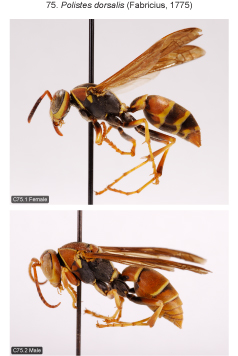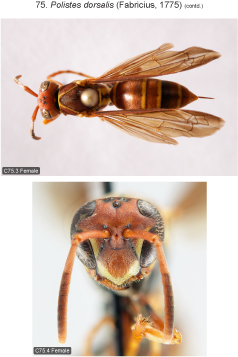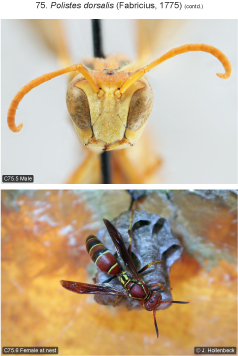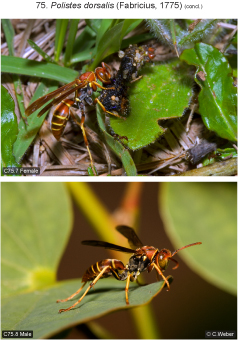
| Home | Table of contents | Keys | Species list | Glossary | Image data | PDF | Cite this article | Feedback | Updates |
Identification Atlas of the Vespidae (Hymenoptera, Aculeata) of the northeastern Nearctic region
CJAI 05, February 19, 2008
doi: 10.3752/cjai.2008.05
Matthias Buck, Stephen A. Marshall, and David K.B. Cheung
Department of Environmental Biology, University of Guelph, Guelph, Ontario, Canada N1G 2W1
Next species | Previous species | Key
75. Polistes dorsalis (Fabricius, 1775)
Figs B10.29–32, 50; C75.1–8.
 |
 |
 |

Species recognition. This is the smallest species of the genus in our area. Its colour pattern is similar to ferruginous forms of P. fuscatus and dark forms of P. bellicosus. Females of P. dorsalis can be separated from P. bellicosus by the presence of black or brown markings on the femora (completely ferruginous in P. bellicosus) and from lighter forms of P. fuscatus by the black or brown hind femoral mark forming a complete ring (dorsally interrupted by ferruginous in P. fuscatus). The latter character varies geographically and is only reliable in eastern populations (we have seen P. d. dorsalis females from Mississippi and Texas in which the femoral ring is interrupted). Dark forms of P. fuscatus often possess a complete black femoral ring as well but show black markings in areas where they are always absent in P. dorsalis (e.g., on clypeal disc) and/or lack ferruginous marks where they are always present in P. dorsalis (e.g., on pronotum and tergum 2). Polistes dorsalis occasionally shows colour patterns that are unique and immediately distinguish it from other species of the P. fuscatus-group: females sometimes possess a yellow mesopleural spot just below the end of the scrobal furrow (rarely present in extralimital P. bellicosus), and xanthic specimens of both sexes never show four discrete yellow propodeal stripes as do certain xanthic forms of P. fuscatus and P. bellicosus. In the latter two species the lateral propodeal stripes are always closer to the metapleural suture than to the paramedian stripes, whereas in P. dorsalis the lateral and paramedian stripes are either confluent (sometimes rendering most of the propodeum yellow) or the lateral stripes are irregular in shape and closer to the paramedian stripes than to the metapleural suture. The male of P. dorsalis shows two unique morphological characters that immediately separate it from other species in the P. fuscatus-group: an unusually prominent median tubercle of sternum 7 (visible in profile) and dull (as opposed to shining) tyloids on the apical flagellomeres.
Variation. Fore wing length 10.0–13.0 mm (both sexes). Female. Yellow markings of head always present, typically forming a V-shaped apical mark on clypeus, sometimes reduced to a small apical spot; supra-antennal stripes absent, rarely present but then strongly suffused with ferruginous; stripes on inner orbit always present, usually not dipping into ocular sinus; postocular stripe on gena, if present, rarely extending to base of mandible; mandible usually more or less yellowish, its base rarely clear yellow. Black markings usually quite restricted; ocellar mark large and rectangular to extremely reduced, leaving only narrow rings around each ocellus, never connected to black spot (if present) above antennal socket; supraclypeal area and sutures between antennal socket and clypeus sometimes marked with black; occiput completely black to largely ferruginous. Antenna with dorsal surface including scape often black or brown but in specimens from southern U.S. scape, pedicel and flagellomeres I, IX and X often entirely ferruginous, and dorsal surface of remainder of flagellomeres only slightly darker. Mesosoma usually largely black, ferruginous markings at least present on dorsal half of pronotum and posterior 2/3 of scutellum (on latter rarely largely replaced with black). The most ferruginous specimens lacking black on entire dorsal surface of mesosoma (excluding suture between scutum and scutellum), but median furrow of propodeum at least in part black; pleuron with substantial black or brown markings including lower parts of mesopleuron (above mid coxa, and around metapleural and midventral sutures) and metapleuron except centre of lower plate (pleuron almost entirely ferruginous in some specimens from southwestern localities, e.g., Mississippi). Yellow markings of mesosoma quite constant and well developed; small yellow spot below ventral end of scrobal furrow sometimes present; propodeal stripes never abbreviated, of normal width to very wide, sometimes with irregular confluent or separate lateral spots, which are always closer to the paramedian stripes than to the metapleural suture (unlike other species), never with regular lateral stripes as in P. fuscatus or P. bellicosus, in extreme cases most of propodeum yellow (the latter typical for ssp. neotropicus and maritimus). Coxae almost always largely black to dark brown, occasionally with more or less developed ferruginous spots, rarely with very small yellow spots. Femora always with black or dark brown basal markings, increasing in size from fore to hind femur, forming ring on hind femur. Yellow markings usually well developed on femora and tibiae. Metasoma usually largely ferruginous with more or less developed black basal bands on terga and sterna. The darkest specimens have ferruginous markings restricted to a pair of large spots on tergum 2, posterior part of tergum 5 and segment 6. The most ferruginous specimens lack black tergal markings and possess very restricted black sternal markings (e.g., base of sternum 2). Yellow fasciae well developed, typically present on terga 1–4, occasionally 1–5, rarely 1–3 (some stylopized specimens only 1–2); sterna typically with complete fascia on sternum 2 and more or less interrupted ones on 3 and 4; occasionally fasciae completely absent. Male similar to female, differing as follows: face yellow up to level of ocular sinuses (rarely entire mid section of frons and dorsomedial 2/3 of clypeus ferruginous), anteroventral part of mesopleuron yellow (rarely reduced to a pair of small spots); anterior surfaces of fore and mid coxae more or less entirely yellow, sometimes spots on anterior surface of hind coxa (rarely up to 2/3); anterior yellow stripes on fore and mid femora, sometimes also on hind femora; sternum 1 often and base of 2 usually with yellow spot; sterna 2–(5)6 with yellow apical fasciae. Ferruginous areas of mesosoma on average smaller than in female, usually absent or minute on pleuron and propodeum.
Distribution. Not recorded from Canada. The nominate subspecies occurs in the eastern and southern U.S. from southwestern MA, southeastern NY, NJ, MD, and WV (Hampshire Co., new state record, DEBU, presented by S. Droege) south to FL and west to TX and AZ (Bohart and Bechtel 1957), Mexico south to Guerrero, and Jamaica (Carpenter 1996a). Richards (1978) and Carpenter (1996a) gave Virginia as the northern limit of its distribution. The subspecies neotropicus Bequaert, 1940 ranges from CO, NM and TX south to Costa Rica, and subspecies californicus Bohart, 1949 from AZ and CA to northwestern Mexico (Chihuahua and Baja California to Sinaloa); ssp. maritimus Bequaert, 1940 occurs on the Bahamas (Andros I.) and ssp. clarionensis Bohart, 1949 on Clarion I. and the Revillagigedo group off the Pacific coast of Mexico.
Biology. Nests in shrubbery and beneath eaves (Krombein 1979).
Next species | Previous species | Key
| Home | Table of contents | Keys | Species list | Glossary | Image data | PDF | Cite this article | Feedback | Updates |
